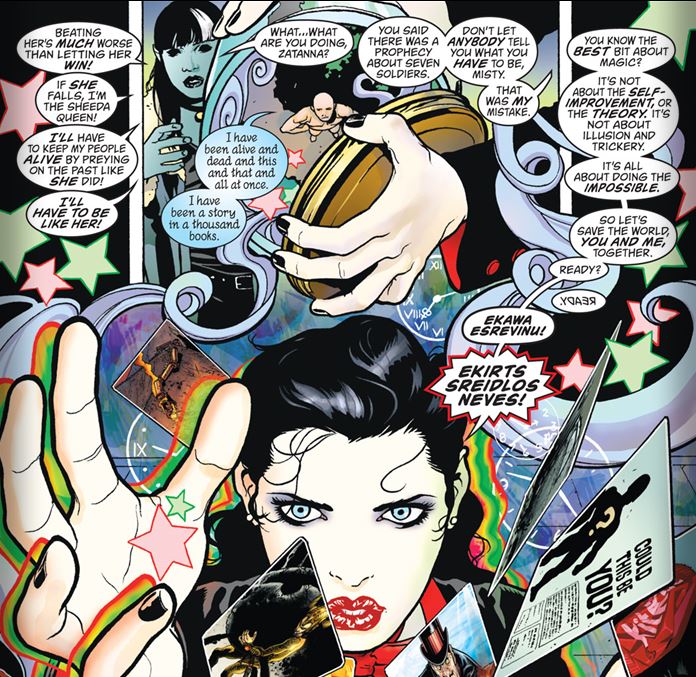Hello, readers! It’s been awhile. This blog hasn’t been updated for a couple years, but if we know anything about comic books, it’s that nothing ever stays dead. So NBN’s comic book blog is getting the ol’ Bucky Barnes treatment, roaring back from the Internet graveyard to give you the latest news and commentary on the world of comic books. First up: the work of superstar comic writer and part-time chaos magician Grant Morrison.
Grant Morrison is the closest thing to a celebrity comic book writer. With his shaved head, athletic build and all-black top-dollar Italian suits, he certainly doesn’t look like the shlubby stereotype of a typical comic convention-goer. He doesn’t act like one, either, having spent years traveling the world, getting high in the Himalayas, hallucinating alien abductions and cross-dressing for chaos magic rituals in between writing superhero comics.
As you might expect from someone with that resume, Morrison’s comics consistently challenge traditional ideas of genre and culture (he loves shattering the fourth wall). But beneath all the superficial cool, at their core his comics retain the optimism of an 8-year old boy discovering Superman for the first time and, quite honestly, represents the best the superhero genre has to offer. As such, they make great reading for anyone interested by innovative, thought-provoking superhero comics.
Morrison’s oeuvre represents decades of work, but here are some good starter points for anyone interested in the comic industry’s resident rock star/chaos magician/free-thinker.
New X-Men
As the years go by, I find myself liking the X-Men less and less. This is probably Grant Morrison’s fault - he wrote them too well.
Over the course of his three-year run on New X-Men, Morrison reimagined Marvel’s most popular superhero franchise from the ground up. He saw the X-Men not as a superhero team but as aid workers for the constantly endangered mutant population. He took them out of gaudy spandex costumes and into black and yellow flak jackets, a look later replicated for Bryan Singer’s movie adaptations. His mutants were not an appropriation of minority struggles but a representation for underground youth culture. Morrison’s New X-Men imagined a vibrant mutant culture: designer clothes for six-armed teenagers, drugs for kids made out of living plasma? It’s all very interesting and thought-provoking, but thankfully it’s also wildly entertaining, with terrifying villains, huge stakes and thrilling sequences.
The revolving team of artists on New X-Men can get disorienting, especially since some are much better than others, but the main downside is that Morrison’s aggressive reimaging of many core X-Men concepts makes it difficult to ever read a traditional X-Men comic again. It’s hard to take Magneto’s operatic antihero shtick seriously once you’ve experienced Morrison’s brilliant deconstruction of the X-Men’s traditional archenemy.
New X-Men is available in three collected paperback editions or one gigantic hardcover omnibus.
All-Star Superman
DC’s short-lived “All-Star” imprint paired up popular artists and writers and gave them a go at the company’s most tenured characters, free of any continuity restraints. Morrison and frequent collaborator Frank Quitely used that freedom to create a beautiful, timeless fable about why Superman matters. It begins with Superman contracting a lethal case of radiation poisoning, and the subsequent issues depict the twelve Herculean “labors” he must face before his apparently inevitable death. Quitely's dreamlike artwork perfectly complements Morrison’s all-ages subject matter.
Many modern creators try to ground Superman, or wound him, or otherwise make him vulnerable. Henry Cavill's Superman in 2013's Man of Steel seemed to care only about destroying shit. Morrison’s genius is in reminding us that the beauty of Superman comes from his invulnerability and his constant striving to save everyone. Seeing the world through Superman’s eyes, Morrison tells us, is to see a world full of joy, a world worth saving.
It is one of the most beautiful comics I’ve ever read.
Seven Soldiers of Victory

Having already reimagined the Doom Patrol and X-Men, with Seven Soldiers of Victory Morrison redid the entire concept of the superhero team. Seven Soldiers consists of seven four-issue miniseries, each focusing on an underused DC Comics character: Shining Knight, Guardian, Klarion the Witch Boy, Zatanna, Mr. Miracle, Frankenstein and Bulleteer. All seven heroes have to work together to defeat an alien menace called the Sheeda without ever meeting one another, though strands weave throughout all seven series.
Two bookend issues tie the whole thing together, but in the meantime each series explores a different genre of adventure fiction: pulp horror, sword-and-sorcery fantasy … there’s even a buddy cop setup with two fashionable female magicians. In the process, Seven Soldiers demonstrates DC’s strength: a wealth of crazy but highly imaginative concepts and characters. It chooses pure, joyful entertainment over the gritty "realism" of deconstructive comics like Alan Moore’s Watchmen.
In an age where some comic issues are selling for $4.99 apiece, Morrison’s work rewards bang-for-your-buck rereading, Seven Soldiers perhaps most of all. The series is available in two collected paperback editions, and makes for endless rereading. The seven series fit together like a puzzle, and rereading them in different orders highlights hidden themes and plot point hints that you can easily miss the first time.
Like I said, this is a small selection. If you find yourself craving more Morrison, I’d also heartily recommend his recently concluded, seven-year epic run on Batman. In the wake of Christopher Nolan’s movie adaptations, it’s a strong reminder that Batman doesn’t necessarily have to be “realistic” to be entertaining. The Invisibles is Morrison’s primary foray into non-superhero comics and showcases all his crazy ideas on fashion, magic and philosophy. He also wrote a real book, Supergods, that's half auto-biography, half history of superhero comics.
That’s all for now, dear readers! Next time, we’ll be discussing Marvel NOW! and what makes a good “reboot.”